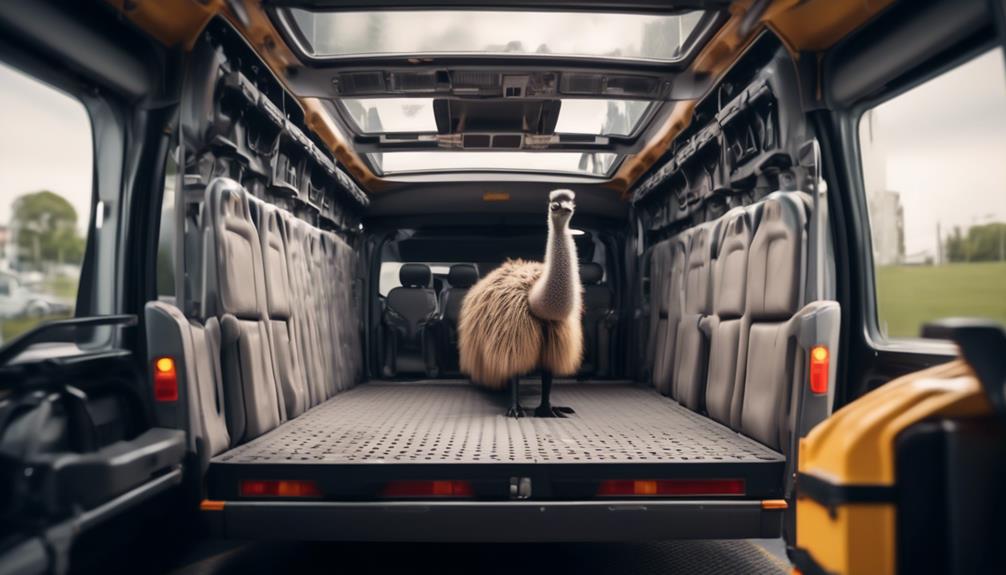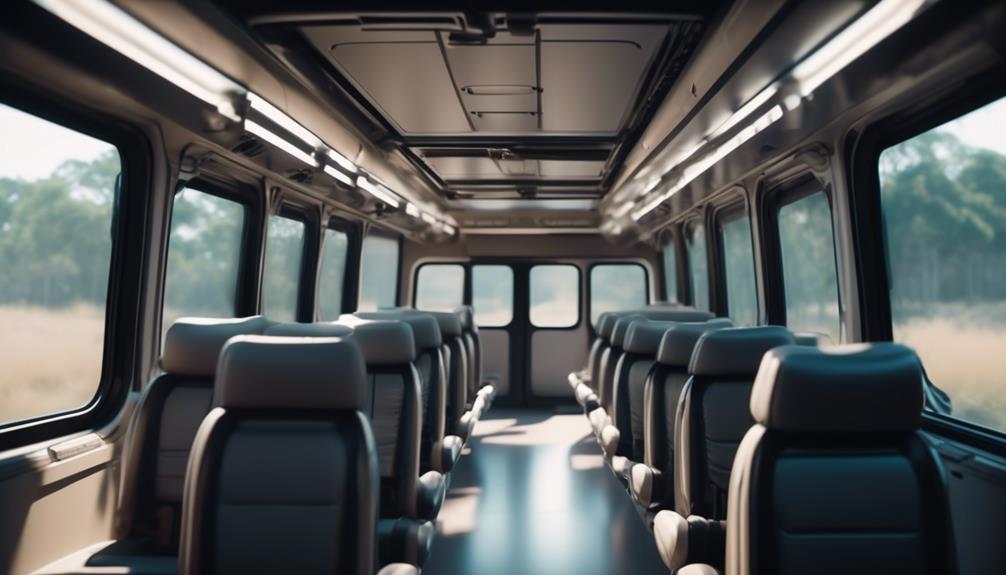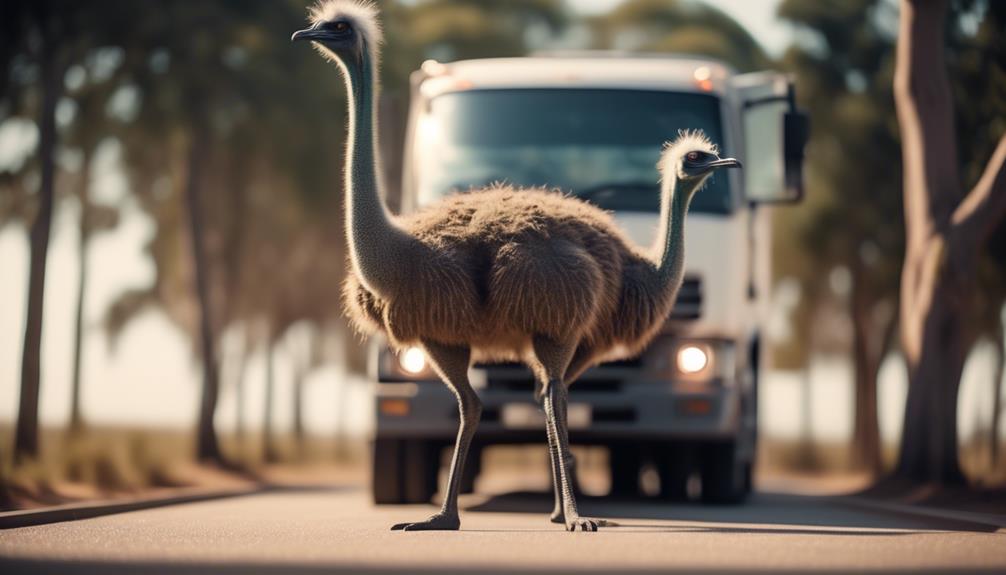
Imagine transporting emus is like orchestrating a delicate ballet, where every step must be carefully planned and executed. To ensure the safety and well-being of these remarkable creatures, it is crucial to adhere to the best practices for their transportation.
But what are these practices exactly? How can you guarantee that emus are transported safely and humanely?
In this discussion, we will explore the essential guidelines for preparing the transport vehicle, securing the emus, monitoring environmental conditions, and arranging for necessary veterinary care.
By following these recommendations, you will not only ensure the welfare of the emus but also maintain their health and happiness throughout the journey. So, let's dive into the world of emu transportation and discover the key to a seamless and stress-free transport experience.
Emu Transportation Requirements

To ensure the safe and humane transportation of emus, it's essential to adhere to specific requirements that prioritize their well-being and minimize stress during the journey. Emu transport regulations and safety guidelines have been put in place to protect these magnificent creatures and ensure their comfort throughout the transportation process.
First and foremost, it's crucial to select an appropriate mode of transport for emus. Whether it's by road, rail, or air, the chosen method must provide adequate space and ventilation to prevent overcrowding and promote proper airflow. Emus should be transported in well-designed containers or crates that are secure and spacious enough to allow them to stand, turn around, and lie down comfortably.
Furthermore, the transportation vehicle must be equipped with features that ensure the safety of the emus. This includes securing the crates or containers to prevent any movement during transit and minimizing vibrations to reduce stress. The vehicle should also have temperature control mechanisms to maintain a suitable environment for the emus, especially during extreme weather conditions.
Additionally, it's crucial for transporters to be trained in handling emus and be aware of their specific needs. They should be knowledgeable about emu behavior, stress signals, and appropriate feeding and watering intervals during the journey. Regular stops should be scheduled to provide emus with access to fresh water and food, allowing them to rest and stretch their legs.
Preparing the Transport Vehicle
Preparing the transport vehicle involves ensuring that it's properly equipped and arranged to provide a safe and comfortable environment for the emus during transit. This step is crucial in minimizing stress and ensuring the well-being of these magnificent creatures. Here are three key considerations to keep in mind when preparing your transport vehicle:
- Proper Ventilation: Emus require fresh air during transit to maintain optimal health. Ensure that your vehicle has adequate ventilation to prevent the build-up of heat and humidity. This can be achieved by installing windows that can be opened or using ventilation fans.
- Secure Enclosure: Emus can become agitated and potentially injure themselves if they aren't properly contained. Make sure the transport vehicle has a sturdy enclosure that prevents escape and provides enough space for the emus to stand and move around comfortably.
- Proper Documentation: It's essential to have all necessary documentation when transporting emus to comply with legal requirements and ensure traceability. This includes health certificates, permits, and any other relevant paperwork. Ensure that these documents are easily accessible during the journey.
Ensuring Adequate Ventilation

Now that the transport vehicle has been properly equipped and arranged, the next crucial step in ensuring the safe and comfortable transit of emus is ensuring adequate ventilation. Proper ventilation is essential for maintaining the health and well-being of the emus during transportation. Ventilation systems play a vital role in controlling temperature, humidity, and air quality inside the vehicle.
To ensure optimal ventilation, it is important to consider the following factors:
| Ventilation System Component | Importance |
|---|---|
| Air vents | Allows fresh air to enter |
| Fans | Promotes air circulation |
| Temperature control | Regulates the temperature inside |
| Air quality monitoring | Ensures clean and healthy air |
The adequate supply of fresh air is crucial for the emus' respiratory health. The ventilation system should be designed to prevent the buildup of heat, humidity, and noxious gases. Regular monitoring of the air quality is necessary to ensure that the emus are not exposed to harmful contaminants.
Securing Emus for Transport
Emus should be securely restrained in the transport vehicle to ensure their safety and prevent any potential injuries during transit. Properly securing emus is crucial for preventing escape and minimizing stress.
Here are three important steps to follow when securing emus for transport:
- Use sturdy, well-ventilated crates: Emus should be transported in crates that are specifically designed for their size and needs. These crates should be made of durable materials to withstand the emus' weight and movements during transport. Additionally, the crates should have adequate ventilation to ensure proper airflow and minimize stress.
- Secure the crates properly: It's essential to securely fasten the crates in the transport vehicle to prevent any movement or shifting during transit. Use strong straps or ropes to secure the crates to the vehicle's floor or walls. This will prevent any potential accidents and injuries that may occur due to crate movement.
- Provide adequate bedding and padding: Emus should be provided with suitable bedding and padding inside the crates to ensure their comfort and safety. This will help minimize stress during transport and provide a cushioning effect in case of sudden movements or bumps on the road.
Providing Comfortable Flooring

For optimal comfort during transportation, it's important to provide emus with a flooring that's both supportive and cushioned. Emus, with their long legs and delicate feet, are particularly susceptible to discomfort and injuries caused by a hard or uneven surface. To ensure their well-being, it's crucial to utilize cushioning material that offers adequate support and protection.
When selecting a cushioning material, consider options such as rubber mats or thick layers of straw. These materials provide a soft and resilient surface that can absorb shock and minimize the pressure on the emus' feet and joints. Additionally, they offer insulation from extreme temperatures and reduce the risk of slips or falls during transit.
Equally important is the need for a non-slip surface. Emus can easily lose their balance, especially when the transport vehicle is in motion or when they're startled. To prevent injuries, the flooring should have a textured surface that enhances grip and stability. This can be achieved by adding rubber matting with raised patterns or by using anti-slip coatings.
Monitoring Temperature and Humidity
To ensure the safe and humane transportation of emus, it's crucial to closely monitor the temperature and humidity levels within the transport vehicle. Emus are sensitive creatures, and improper temperature control and moisture management can lead to stress, illness, or even death.
Here are three essential practices to follow when monitoring temperature and humidity during emu transportation:
- Maintain Optimal Temperature: Emus thrive in temperatures between 50°F and 80°F (10°C and 27°C). Ensure the transport vehicle is equipped with proper insulation and ventilation to regulate the temperature effectively. Use temperature monitoring devices to keep track of any fluctuations and make necessary adjustments promptly.
- Control Humidity Levels: Emus require a relative humidity level of 40% to 70% to stay comfortable and healthy. Excess humidity can lead to respiratory issues, while low humidity can cause dehydration. Use humidifiers or dehumidifiers to maintain the desired humidity range and avoid any extreme conditions.
- Regularly Check and Adjust: Continuously monitor the temperature and humidity levels throughout the journey. Make sure to check the readings at regular intervals and adjust the settings if needed. Stay vigilant and make necessary modifications to ensure the emus' well-being.
Handling and Loading Emus Safely

Ensuring the safe and efficient handling and loading of emus is crucial for their well-being during transportation. Emus are large and powerful birds, and improper handling techniques can cause stress and injury to both the birds and the handlers. Therefore, it is important to follow proper emu handling techniques to ensure a smooth and safe loading process.
When loading and unloading emus, it is essential to have a well-designed facility that minimizes stress and provides a controlled environment. Here are some key loading and unloading procedures to follow:
| Loading and Unloading Procedures |
|---|
| Provide a quiet and calm environment |
| Use a chute or ramp for easy access |
| Use gentle pressure to guide emus |
| Avoid excessive noise and sudden movements |
| Ensure proper ventilation during loading |
These procedures will help minimize stress and ensure the safety of the emus during the loading and unloading process. Remember, emus are sensitive animals, and handling them with care and respect is essential for their well-being.
Arranging for Veterinary Care During Transport
When preparing to transport emus, it's crucial to ensure that arrangements are made for veterinary care during the journey to prioritize the well-being and health of these magnificent birds. Emus, like any other animals, may experience health issues or injuries during transport. It's essential to be prepared and have a plan in place to address any emergencies that may arise.
Here are three important steps to take when arranging for veterinary care during emu transport:
- Arrange for emergency assistance: Before embarking on the journey, ensure that you have the contact information of a reliable veterinarian who specializes in avian care. This professional should be available to provide immediate assistance in case of emergencies. Make sure to have a well-stocked first aid kit designed specifically for emus on hand.
- Coordinate with local authorities: Research the local regulations and requirements of the areas through which you'll be transporting the emus. Contact the relevant authorities to inform them about your transport plans and inquire about any specific veterinary care or health certificates that may be necessary. This will help ensure compliance with the law and facilitate a smooth journey.
- Regularly monitor and assess the emus: During transport, closely observe the emus for any signs of distress, illness, or injury. A trained animal care professional should conduct regular check-ups to monitor their health and well-being. If any issues arise, promptly seek veterinary assistance to address them.
Frequently Asked Questions
What Are the Recommended Safety Measures for Transporting Emus by Air?
To transport emus by air safely, it is crucial to secure them in proper crates to prevent injury during flight. Additionally, the transport vehicle should have adequate ventilation, temperature control, and lighting for their well-being.
Can Emus Be Transported in Regular Livestock Trailers?
Regular livestock trailers may not be suitable for transporting emus safely and humanely. Emus have specific needs during transit, and there are regulations governing emu transport. Consider specialized trailers designed with emus in mind.
How Should Emus Be Handled and Secured During Long-Distance Transportation?
When transporting emus long-distance, it's crucial to handle them with care and ensure they are secured properly in the transport vehicle. This ensures their safety and prevents any unnecessary stress or harm.
Is It Necessary to Sedate Emus Before Loading Them Onto the Transport Vehicle?
No need to knock 'em out! Sedating emus before loading may seem like a good idea, but it's not necessary. With proper loading techniques and a calm approach, you can transport these majestic birds safely and humanely.
What Are the Specific Requirements for Emu Transport in Extreme Weather Conditions?
When transporting emus in extreme weather conditions, it is crucial to follow emu transport guidelines to ensure their safety and well-being. Take extreme weather precautions, such as providing proper ventilation and temperature control, to minimize stress and keep the emus comfortable.
Conclusion
As you conclude your journey of understanding the best practices for transporting emus safely and humanely, remember that these magnificent creatures rely on us for their well-being.
Just as we carefully secure and monitor their transport conditions, let's symbolize our commitment to their care by fostering a world where compassion and expertise interlace.
By following the technical guidelines provided, we can ensure that each emu's voyage is characterized by comfort, safety, and a profound respect for their existence.





